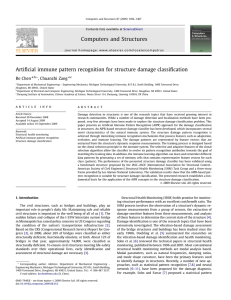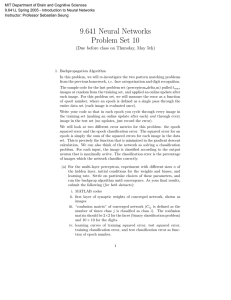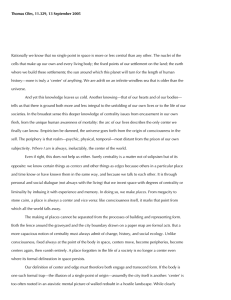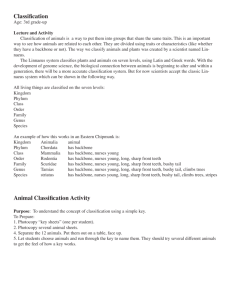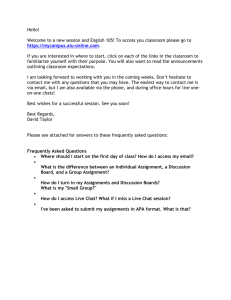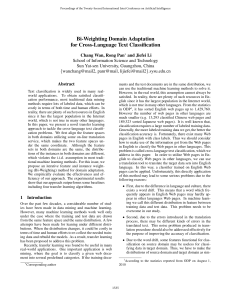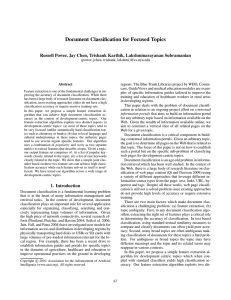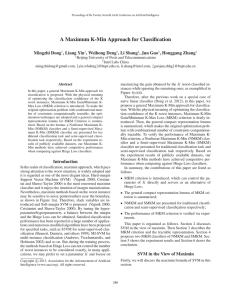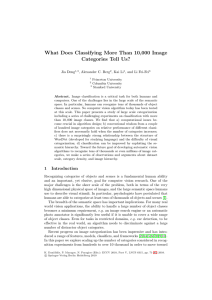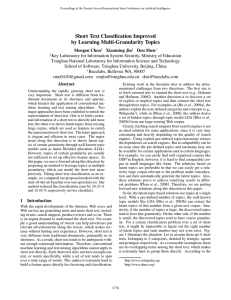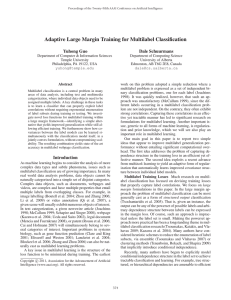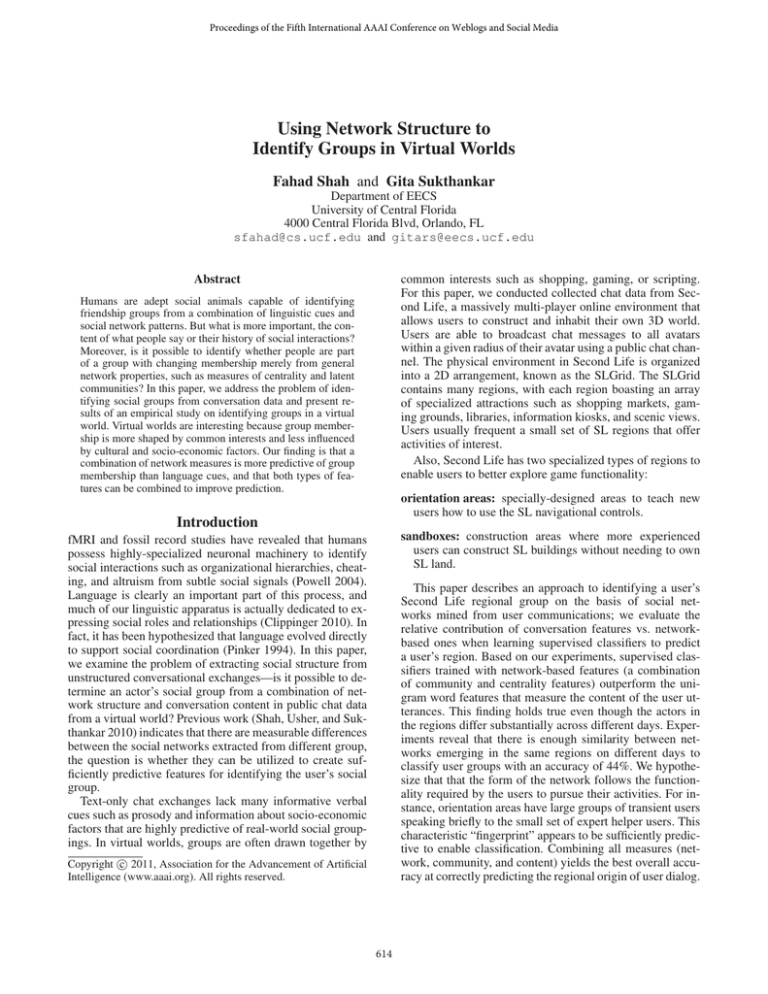
Proceedings of the Fifth International AAAI Conference on Weblogs and Social Media
Using Network Structure to
Identify Groups in Virtual Worlds
Fahad Shah and Gita Sukthankar
Department of EECS
University of Central Florida
4000 Central Florida Blvd, Orlando, FL
sfahad@cs.ucf.edu and gitars@eecs.ucf.edu
common interests such as shopping, gaming, or scripting.
For this paper, we conducted collected chat data from Second Life, a massively multi-player online environment that
allows users to construct and inhabit their own 3D world.
Users are able to broadcast chat messages to all avatars
within a given radius of their avatar using a public chat channel. The physical environment in Second Life is organized
into a 2D arrangement, known as the SLGrid. The SLGrid
contains many regions, with each region boasting an array
of specialized attractions such as shopping markets, gaming grounds, libraries, information kiosks, and scenic views.
Users usually frequent a small set of SL regions that offer
activities of interest.
Also, Second Life has two specialized types of regions to
enable users to better explore game functionality:
Abstract
Humans are adept social animals capable of identifying
friendship groups from a combination of linguistic cues and
social network patterns. But what is more important, the content of what people say or their history of social interactions?
Moreover, is it possible to identify whether people are part
of a group with changing membership merely from general
network properties, such as measures of centrality and latent
communities? In this paper, we address the problem of identifying social groups from conversation data and present results of an empirical study on identifying groups in a virtual
world. Virtual worlds are interesting because group membership is more shaped by common interests and less influenced
by cultural and socio-economic factors. Our finding is that a
combination of network measures is more predictive of group
membership than language cues, and that both types of features can be combined to improve prediction.
orientation areas: specially-designed areas to teach new
users how to use the SL navigational controls.
Introduction
sandboxes: construction areas where more experienced
users can construct SL buildings without needing to own
SL land.
fMRI and fossil record studies have revealed that humans
possess highly-specialized neuronal machinery to identify
social interactions such as organizational hierarchies, cheating, and altruism from subtle social signals (Powell 2004).
Language is clearly an important part of this process, and
much of our linguistic apparatus is actually dedicated to expressing social roles and relationships (Clippinger 2010). In
fact, it has been hypothesized that language evolved directly
to support social coordination (Pinker 1994). In this paper,
we examine the problem of extracting social structure from
unstructured conversational exchanges—is it possible to determine an actor’s social group from a combination of network structure and conversation content in public chat data
from a virtual world? Previous work (Shah, Usher, and Sukthankar 2010) indicates that there are measurable differences
between the social networks extracted from different group,
the question is whether they can be utilized to create sufficiently predictive features for identifying the user’s social
group.
Text-only chat exchanges lack many informative verbal
cues such as prosody and information about socio-economic
factors that are highly predictive of real-world social groupings. In virtual worlds, groups are often drawn together by
This paper describes an approach to identifying a user’s
Second Life regional group on the basis of social networks mined from user communications; we evaluate the
relative contribution of conversation features vs. networkbased ones when learning supervised classifiers to predict
a user’s region. Based on our experiments, supervised classifiers trained with network-based features (a combination
of community and centrality features) outperform the unigram word features that measure the content of the user utterances. This finding holds true even though the actors in
the regions differ substantially across different days. Experiments reveal that there is enough similarity between networks emerging in the same regions on different days to
classify user groups with an accuracy of 44%. We hypothesize that that the form of the network follows the functionality required by the users to pursue their activities. For instance, orientation areas have large groups of transient users
speaking briefly to the small set of expert helper users. This
characteristic “fingerprint” appears to be sufficiently predictive to enable classification. Combining all measures (network, community, and content) yields the best overall accuracy at correctly predicting the regional origin of user dialog.
c 2011, Association for the Advancement of Artificial
Copyright Intelligence (www.aaai.org). All rights reserved.
614
To collect data on social interactions in Second Life, we
launched six agent bots (each with a different Second Life
account and avatar) in different regions listed in Table 1,
over multiple consecutive days and randomly selected 4
days of data for analysis.
Because of an inability to use statistical machine learning approaches due to the lack of sufficiently labeled data
and absence of a tagger/parser that can interpret chat dialog
data, we opted to use the Shallow Semantics and Temporal Overlap algorithm (SSTO), a rule-based algorithm that
relies on shallow semantic analysis of commonly occurring
linguistic cues that frequently occur in chat data (Shah and
Sukthankar 2011). SSTO employs the following cues:
salutations: Salutations are frequent and can be identified
using keywords such as “hi”, “hello”, “hey”. The initial
speaker is marked as the from user and users that respond
within a designated temporal window are labeled as to
users.
questions: Question words (e.g., “who”, “what”, “how”)
are treated in the same way as salutations. We apply the
same logic to requests for help (which are often marked
by words such as “can”, “would”).
usernames: When a dialog begins or ends with all or part
of a username (observed during the analysis period), the
username is marked as to, and the speaker marked as from.
second person pronouns: If the dialog begins with a second person pronoun (i.e., “you”, “your”), then the previous speaker is considered as the from user and the current
speaker the to user; explicit mentions of a username override this.
temporal co-occurrences: SSTO includes rules for linking users based on temporal co-occurrence of utterances.
These rules are triggered by a running conversation of 8–
12 utterances.
The output of SSTO is a to/from labeling for the chat dialogs
with directed links between users. Unfortunately SSTO is
not extremely accurate so the resulting social networks have
both extraneous and missing links, but is more robust to
poorly conditioned input than other network text analysis
techniques for this task. The resulting networks were then
used for extracting feature sets for the classification task.
Table 1: Second Life region descriptions
Region
Help Island Public
Help People Island
Mauve
Kuula
Moose Beach
Pondi Beach
Region Description
Orientation area
Orientation area
Sandbox
Sandbox
Scenic area
Scenic area
Figure 1: Multi-agent architecture for Second Life data collection
Approach
In this section, we describe our method for identifying user’s
regional groups. Table 1 contains a description of the Second Life regions that we used for our study. Our goal is to
identify each user’s region-based group based on a combination of network, community, and conversational content
features. Our study includes a three basic types of regions:
1) orientation areas, 2) sandboxes for scripting and building,
and 3) scenic areas. Many regions include multiple attraction types, but we categorized each region by the dominant
attraction near the bot’s position.
Network Features
Using the linkages extracted from the raw chat logs, we construct social networks of the users in each Second Life region monitored by the bots. These social networks were used
as the basis for both the network and community features
used to train a set of supervised classifiers. For the network
features, we calculate measures of centrality for each node
in the network using the UCINET software (Borgatti, Everett, and Freeman 2002). The centrality measures of nodes
in the network correspond to how connected nodes are to
other nodes. We use three measures of centrality, degree
(measure of centrality indicates the strength of relationships
for a given actor), closeness (the average distance of the actor to all other actors in the network) and betweenness (a
view of the actor based on its presence on the geodesic paths
Data Collection
Figure 1 shows the overall data collection architecture. Multiple bots, stationed in different SL regions, listen to all the
messages within their hearing range on the public chat channel. The bots forward chat messages to the server, which
parses and conditions messages for storage in the dialog
database. Occasionally the server sends the bots navigational commands and an optional dialog response if the bot
is addressed by name. Linkages between SL actors are inferred offline by partitioning the unstructured data into separate conversations; these linkages are used to construct the
graphs used in the social network analysis and community
detection.
615
between pairs of other actors in the network), as the set of
network features (Linton 1979).
Table 2: Hourly token counts
Hour
1
2
3
4
Total
Reduced
Community Features
Based on previous work (Tang and Liu 2009), we hypothesize that community features could be valuable for our user
classification problem. As described in (Newman 2006),
modularity (denoted by Q below) measures the chance of
seeing a node in the network versus its occurrence being
completely random. It can be defined as the sum of the rank i kj
(where Aij is the entry from adjadom chance Aij − 2m
cency matrix and m = 12 i ki the total edges in the network) summed over all pairs of vertices i, j that fall in the
same group, where si equals 1 if the two vertices fall in the
same group and -1 otherwise:
ki kj
1 (Aij −
(1)
Q=
)si sj .
4m
2m
Hour 1
Hour 2
Hour 3
Hour 4
k k
i j
If B is defined as the modularity matrix given by Aij − 2m
,
which is a real symmetric matrix with column vectors whose
elements
n areT si 2then Equation 1 can be written as Q =
1
i=1 (uI s) βi , where βi is the eigenvalue of B corre4m
sponding to the eigenvector
u. ui are the normalized eigenn
vectors of B such that s = i ai ui and ai = uTi s.
We use the leading eigenvector approach to spectral optimization of modularity to perform a loose community partitioning (s being a real number). For the maximum positive contribution to the modularity we use all the eigenvectors that make positive contribution to the modularity (obtained through cross-validation) and take the coefficients for
them as the membership information. We use a membership
threshold of 0.1 to determine whether the contribution is sufficient for community membership.
Number of Tokens
3433
3175
3215
2261
11,994
603
Table 3: Network user counts
Help Help MauveKuula Pondi MooseTotal
IslandPeople
Beach Beach
Public Island
34
19
7
25
27
25 137
30
18
5
16
15
23 107
32
15
6
19
18
24 120
28
22
5
19
16
21 109
Adding bigrams and trigrams drops the classification performance, possibly because of the large number of typos,
acronyms, and emoticons present in our dataset.
6. We evaluated two feature variants: 1) binary encoding of
the presence/absence of terms and 2) weighting the terms
according to a TF-IDF measure. Both feature variants resulted in approximately equivalent classification accuracy
so we used the binary encoding for our feature set.
The dataset collected by our Second Life bots consists of
over 500 hours of data for a period of 4 days. We randomly
selected one hour of data from the four different days for the
term vector analysis. Table 2 summarizes the token counts
over the dataset. There were 11,994 tokens overall, which after processing reduced to 603 terms that were then used for
classifier training. For our classification task we evaluated
the performance of four supervised learning algorithms using the Weka machine learning workbench (Waikato 2009):
1) decision-trees 2) Bayesian belief nets 3) k-nearest neighbor and 4) Naive Bayes and report the best result per feature
group.
Content Features
In addition to the network and community features mined
from the link structure of the networks, we believe that
the language content present in the dialogs offers additional
clues about the user’s regional identity. We opt for a shallow
approach using n-gram analysis.
To extract word features for our dataset, we followed the
procedure outlined below:
1. First we partition the data into chunks consisting of all
spoken dialogs for the time period under consideration.
Documents in our dataset simply correspond to all the utterances from each unique user within the time period.
Results
We obtained conversation data from six different regions in
Second Life over four days of data collection (80,000 total
utterances). A general description of the activities that the
users tend to perform in each region is shown in Table 1. The
regions fell into three different general categories: 1) orientation areas for new users to learn how to interact with Second Life, 2) sandbox areas that permit users to experiment
with building construction, and 3) general entertainment areas (e.g., beaches). The number of actors in each region for
the four hours under consideration is shown in Table 3.
The classification task is to identify the region given the
feature set. We evaluated the following feature sets:
2. Next, we tokenize the dialogs to extract tokens from this
chunk for each user.
3. A stop words list is used to eliminate commonly occurring articles, pronouns, helping verbs and salutations.
4. The Snowball Stemmer (Porter 2001) is used to stem the
words to their root in order to create unique terms for each
region.
5. The top k terms from each region are selected based
on classification cross-validation; terms are removed until the classification performance declines significantly.
616
private chats; we notice from our dataset that the conversations occurring in the public chat forums are very similar
even in regions where the users are participating in different
activities. Due to the volume of user traffic and the variable
duration of user stays, the network structure and the number of communities differ substantially across regions, apparently resulting in more predictive classification features.
This holds true even across data sampled from the same region on different days. Even though many of the actors are
different from day-to-day, the network and community features retain some similarity. Our hypothesis that the form of
the network follows the function that the users need to pursue their activities is not supported by the observed confusion matrices since the classifier mispredictions do not follow simple activity based trends. In future work, we plan to
analyze more task-oriented groups in Second Life, gamers
and shoppers.
Table 4: Classification accuracy by feature set
Feature Set
All Centrality
Closeness Only
Community #
Words (unigrams)
All Centrality and Community
All Centrality and Words
Closeness and Community
Closeness and Words
Community and Words
All Features
Classification Accuracy
25.2%
25.8%
27.5%
34%
21.4%
33.9%
44.4%
38.1%
34.9%
54.3%
• all the centrality measures (betweenness, closeness and
degree),
Acknowledgments
• the most predictive centrality measure, closeness, only,
This research was funded by AFOSR YIP award FA955009-1-0525.
• community membership, expressed as the number of
communities each user belongs to,
References
• the top-k words from the term vector model.
Borgatti, S. P.; Everett, M. G.; and Freeman, L. C. 2002.
UCINET 6 For Windows: Software for Social Network
Analysis.
Clippinger, J. 2010. Human nature and social networks.
Linton, F. C. 1979. Centrality in social networks: Conceptual clarification. Social Networks 1(3):215–239.
Newman, M. 2006. Modularity and community structure
in networks. In Proceedings of the National Academy of
Sciences, volume 103, 8577–8582.
Pinker, S. 1994. The Language Instinct. Harper Collins.
Porter, M. 2001. Snowball: A language for stemming
algorithms. Retrieved Feb 2011 http://snowball.
tartarus.org/texts/introduction.html.
Powell, K. 2004. Brains sniff out scam artists: Evolution
may have programmed us to compute fairness. Retrieved
Feb 2011 http://www.nature.com/nsu/020812/
020812-1.html.
Shah, F., and Sukthankar, G. 2011. Constructing social networks from unstructured group dialog in virtual worlds. In
International Conference on Social Computing, BehavioralCultural Modeling, and Prediction (SBP11).
Shah, F.; Usher, C.; and Sukthankar, G. 2010. Modeling
group dynamics in virtual worlds. In Proceedings of the
Fourth International Conference on Weblogs and Social Media.
Tang, L., and Liu, H. 2009. Relational learning via latent social dimensions. In Proceedings of the 15th ACM
SIGKDD International Conference on Knowledge Discovery and Data Mining, 817–826. ACM.
Waikato, U. 2009. Weka. Retrieved July 2009 http://
www.cs.waikato.ac.nz/ml/weka/.
The statistics shown in the Table 4 were obtained by combining the results from classification for leave-one-out validation for the best classifier. For the leave-one-out validation
we made four splits, where the data from three hours was
used for training the classifier and the data from the fourth
was used as the test set. We selected this scheme to evaluate
whether the learned patterns persist over time and generalize to completely different sets of actors and social networks
from the same region. We performed the classification for
each of these four splits using all the four algorithms and
selected the best performing algorithm for each feature set.
We can make the following conclusions based on the results shown in Table 4:
• Unsurprisingly, using a combination of all the features
provides the best classification performance, 54.3%
• Using any of the features individually, or any combination, provides classification performance better than random chance levels (about 17% for six class problem),
showing all the features carry important information.
• For individual features, the best performance is obtained
from using the words (34%)
• For the combined features, the best performance is obtained by combining closeness with community membership information.
Conclusion
Our empirical study of region-based user groups in the Second Life virtual world reveals that the combination of network and community features can be more predictive of user
groups that the actual content of the conversations. This is
especially the case in real-world open ended conversations
as described in this paper. One explanation for this phenomena is that more meaningful dialogs might be exchanged on
617

